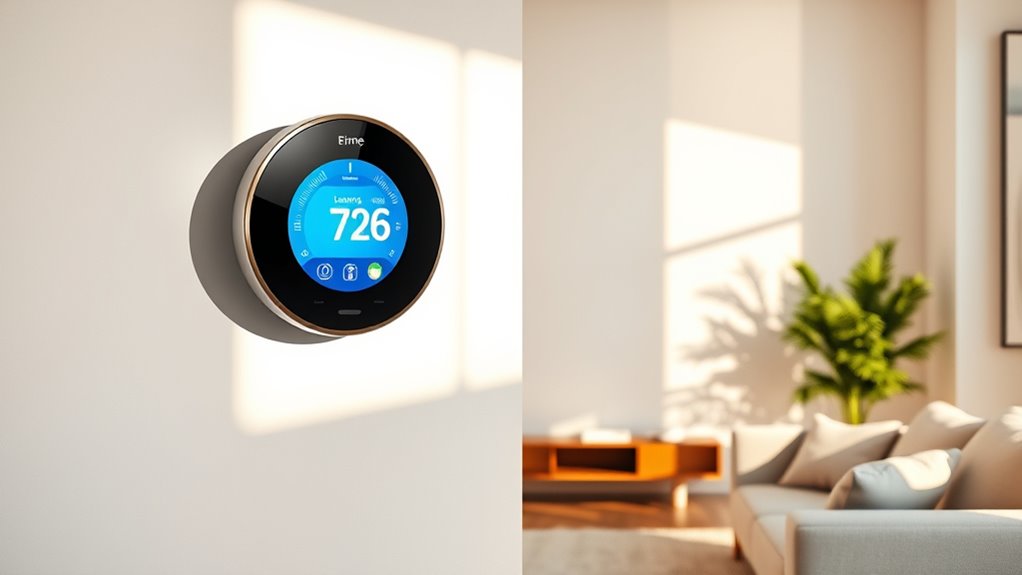If you’re looking for smart thermostats that learn your routines to save energy and money, I recommend models like the Google Nest Learning Thermostat (3rd and 4th gen), ecobee Smart Thermostat Essential, and EMERSON Sensi Touch. These devices use intelligent algorithms to adapt to your habits, optimize comfort, and reduce utility bills. They support voice assistants and work with most HVAC systems. Keep exploring for more details to find the perfect fit for your home.
Key Takeaways
- Advanced learning algorithms in thermostats like Nest and ecobee optimize temperature schedules for energy savings.
- Compatibility with diverse HVAC systems ensures efficient operation and broad usability.
- Features such as occupancy sensors and auto-scheduling adapt to user routines, reducing unnecessary energy use.
- Remote control and smart home integration enable convenient energy management and cost reduction.
- ENERGY STAR certified models guarantee energy-efficient performance, leading to lower utility bills.
ecobee Smart Thermostat Essential – Wi-Fi Programmable Thermostat
If you’re looking for an easy-to-install smart thermostat that saves you money, the ecobee Smart Thermostat Essential is an excellent choice. It’s Energy Star certified, compatible with Siri, Alexa, Google Assistant, and Apple HomeKit, making integration seamless. Designed for DIY installation, it doesn’t even require a C-wire thanks to the Power Extender Kit. With a sleek color touchscreen and intuitive app control, you can set schedules, monitor energy use, and adjust temperatures remotely. It helps reduce heating and cooling costs by up to 23% annually, paying for itself in just six months. Plus, its reliable performance and modern design make it a smart addition to any home.
Best For: homeowners seeking an easy-to-install, energy-efficient smart thermostat compatible with multiple voice assistants and smart home systems.
Pros:
- Easy DIY installation without the need for a C-wire, thanks to the Power Extender Kit
- Compatible with Siri, Alexa, Google Assistant, and Apple HomeKit for seamless smart home integration
- Helps save up to 23% annually on heating and cooling costs, with quick payback within six months
Cons:
- Some users experience difficulty understanding wiring instructions or communicating with customer support
- Limited to 85% HVAC system compatibility; check compatibility before purchase
- The optional cover plate is sold separately, adding to the overall cost for a complete look
Google Nest Learning Thermostat, 3rd Gen
The Google Nest Learning Thermostat, 3rd Gen, stands out as an ideal choice for homeowners seeking to optimize energy efficiency effortlessly. It learns your routines with Auto-Schedule and adjusts automatically, saving energy without manual programming. With Home/Away Assist, it detects when you’re gone and reduces heating or cooling accordingly. The device supports remote control via the Nest app and works seamlessly with Alexa and Google Assistant for voice commands. Its sleek, stainless steel design features a bright, large display. Certified ENERGY STAR, it helps save an average of 10-12% on heating and 15% on cooling, translating to significant annual savings.
Best For: homeowners seeking an easy-to-use, energy-efficient smart thermostat that learns routines and offers remote control and voice compatibility.
Pros:
- Learns user routines automatically with Auto-Schedule, reducing manual programming
- Supports remote control via the Nest app and works with Alexa and Google Assistant for voice commands
- Helps save on energy bills with proven efficiency features and a sleek, modern design
Cons:
- Requires a C wire for proper installation and power supply
- Initial calibration can take some time and may need troubleshooting
- Placement considerations are important for accurate temperature sensing and optimal performance
Google Nest Thermostat and Sensor Bundle (4th & 2nd Gen)
The Google Nest Thermostat and Sensor Bundle (4th & 2nd Gen) stands out as an excellent choice for homeowners seeking an intelligent, energy-efficient solution that adapts seamlessly to their routines. Its sleek design features a larger touchscreen and customizable faceplates, blending well into any home decor. The thermostat supports most 24V systems and is easy to install, even without a C-wire. It offers remote control via the Google Home app, voice commands, and auto-scheduling that learns your preferences. The included Nest Temperature Sensor helps manage hot and cold spots, optimizing comfort while reducing energy costs by an average of 12% on heating and 15% on cooling.
Best For: homeowners seeking a sleek, intelligent thermostat with easy installation and energy-saving features that adapts to their routines.
Pros:
- Stylish, modern design with a larger touchscreen and customizable faceplates
- Supports most 24V heating and cooling systems, often without a C-wire
- Learns user preferences and offers auto-scheduling to optimize comfort and energy savings
Cons:
- Higher price point compared to previous models
- Some compatibility issues outside the US, such as in the UK
- Requires a CR2 battery and may need professional installation for optimal setup
Google Nest Learning Thermostat, 3rd Gen
For those seeking a smart thermostat that adapts to their routines and saves energy automatically, the Google Nest Learning Thermostat (3rd Gen) is an excellent choice. It learns your schedule and preferred temperatures, adjusting settings to maximize comfort and efficiency. You can view your energy usage with the Energy History feature and see when you’re saving money. With remote control via smartphone, tablet, or laptop, you stay in command from anywhere. The device supports Home/Away Assist to switch to Eco Mode when you’re not home. Its sleek stainless steel design, user-friendly display, and smart home compatibility make it a top pick for energy-conscious homeowners.
Best For: homeowners seeking an energy-efficient, intelligent thermostat that learns their routines and offers remote control capabilities.
Pros:
- Learns user schedules for automatic adjustments, enhancing comfort and energy savings
- Remote control via smartphone, tablet, or laptop for convenience from anywhere
- Monitors HVAC systems and provides maintenance alerts to ensure optimal performance
Cons:
- Requires Wi-Fi connection for full functionality and remote access
- Compatible with Nest Temperature Sensors sold separately, adding to overall cost
- Might have a learning curve for users unfamiliar with smart thermostats or home automation
Google Nest Learning Thermostat (4th Gen, 2024) with Nest Temperature Sensor
If you want a smart thermostat that adapts seamlessly to your schedule and maximizes energy savings, the Google Nest Learning Thermostat (4th Gen, 2024) with Nest Temperature Sensor is an excellent choice. Its sleek Obsidian finish and larger display with Dynamic Farsight make it both stylish and easy to read from across the room. It’s compatible with most 24V systems and doesn’t usually require a C wire, simplifying installation. You can control it remotely via the Google Home app or voice commands. The included Nest Temperature Sensor lets you manage different rooms for ideal comfort and efficiency, helping you save on energy bills while maintaining a cozy home.
Best For: homeowners seeking an energy-efficient, stylish smart thermostat that easily integrates with their existing smart home ecosystem and adapts to their schedule.
Pros:
- Larger, clearer display with Dynamic Farsight for easy reading from across the room
- Compatible with most 24V systems and typically no C wire needed for installation
- Supports remote control via Google Home app and voice commands through Alexa, Siri, or Google Assistant
Cons:
- May require a compatible smartphone or smart speaker for full voice control functionality
- Advanced features like schedule adjustments may need user familiarity with smart home apps
- Dependence on Wi-Fi connectivity for remote access and updates
ecobee Smart Thermostat Premium with Sensors
Anyone looking to maximize energy savings and enhance home comfort should consider the ecobee Smart Thermostat Premium with Sensors. It can cut heating and cooling costs by up to 26% annually and is ENERGY STAR certified. The included SmartSensor (worth $50) helps eliminate hot and cold spots by adjusting temperatures in key rooms. Built-in air quality monitoring alerts me to poor conditions and reminds me to change filters. Its occupancy sensing detects open doors or windows, automatically pausing HVAC to save energy. Plus, it integrates with voice assistants, supports remote control via app, and offers sleek, user-friendly design. It’s a smart choice for energy efficiency and comfort.
Best For: homeowners seeking to maximize energy savings, improve home comfort, and utilize smart home integrations with a stylish, user-friendly thermostat.
Pros:
- Up to 26% annual energy cost reduction with ENERGY STAR certification
- Includes SmartSensor to eliminate hot and cold spots for enhanced comfort
- Seamless integration with voice assistants and remote control via user-friendly app
Cons:
- Installation can be complex and may require professional help, especially for advanced wiring
- Some features, like Apple HomeKit, may need additional hubs or accessories
- Touch-sensitive interface might be challenging for visually impaired users
Google Nest Thermostat, Programmable Wi-Fi Smart Thermostat
The Google Nest Thermostat stands out as an ideal choice for homeowners seeking a smart, energy-efficient solution that combines convenience with advanced learning capabilities. It offers remote control via the Google Home app and voice commands, making it easy to adjust settings from anywhere. Its ENERGY STAR certification guarantees it helps save energy and reduce utility bills. The sleek, wall-mountable design fits seamlessly into any home, and setup usually takes about 30 minutes. With features like scheduling, system health monitoring, and compatibility with major smart home platforms, it’s a versatile option for those wanting a reliable, user-friendly thermostat that learns your habits over time.
Best For: homeowners seeking a smart, energy-efficient thermostat that offers remote control, easy scheduling, and compatibility with popular smart home platforms.
Pros:
- Easy to control remotely via the Google Home app and voice commands.
- ENERGY STAR certified, helping to reduce energy consumption and utility bills.
- Sleek, wall-mountable design with simple setup typically completed in about 30 minutes.
Cons:
- May require additional wiring or a C wire for certain HVAC systems, which can complicate installation.
- Initial temperature calibration issues reported by some users, affecting accuracy.
- Limited customer support options and reliance on community resources for troubleshooting.
ecobee Smart Thermostat Enhanced, WiFi Programmable Thermostat
The ecobee Smart Thermostat Enhanced is an excellent choice for homeowners seeking automatic energy savings and advanced comfort control. It adjusts temperatures based on occupancy, suggests schedule changes, and optimizes energy use, saving up to 26% annually. It preheats or precools your home before you arrive, maintains comfort during sleep, and manages humidity for consistent temperatures. Compatible with most 24 VAC HVAC systems, it’s easy to install with a sleek design and intuitive app control. With smart sensors and seamless smart home integration, it offers reliable, efficient climate management that simplifies home comfort while reducing costs.
Best For: homeowners seeking an energy-efficient, smart, and easy-to-install thermostat that offers advanced control and seamless smart home integration.
Pros:
- Automatic energy savings with occupancy-based adjustments and smart scheduling
- Modern, sleek design with intuitive touchscreen and app control
- Compatible with most 24 VAC HVAC systems and includes a Power Extender Kit for easy installation
Cons:
- Limited geofence options for location-based automation
- Some users desire longer fan run times after cooling cycles
- Compatibility concerns with certain HVAC systems or seller reliability issues
Amazon Smart Thermostat
If you’re looking for a smart thermostat that seamlessly integrates with your existing smart home setup, the Amazon Smart Thermostat is an excellent choice. It’s compact, made with Honeywell technology, and compatible with most 24V HVAC systems like force air, heat pumps, and radiant boilers—though not electric baseboard heat. Setup is straightforward via the Alexa app, and it offers features like automatic temperature adjustments, remote control, and scheduling. With ENERGY STAR certification and energy-saving dashboards, it helps reduce bills. While it lacks a far-field microphone, voice control works well through Alexa devices. Overall, it’s a reliable, cost-effective option for smart home enthusiasts.
Best For: homeowners seeking a user-friendly, energy-efficient smart thermostat that integrates seamlessly with Alexa and existing HVAC systems.
Pros:
- Easy installation and setup via the Alexa app with automated Wi-Fi connection.
- Compatible with most 24V HVAC systems, including heat pumps and radiant boilers.
- ENERGY STAR certified, helping reduce energy bills through smart scheduling and monitoring.
Cons:
- Not compatible with 110-240V systems like electric baseboard heat.
- No built-in far-field microphone for voice commands; relies on Alexa devices.
- Some users experience app crashes on older Android devices, affecting scheduling features.
Google Nest Thermostat, Programmable WiFi Thermostat
For homeowners seeking to cut energy costs without sacrificing comfort, the Google Nest Thermostat stands out with its intelligent learning capabilities. It supports heating, cooling, and heat pump systems, featuring a sleek LCD display and easy button controls. Installation is straightforward, often completed within 30 minutes, and it connects seamlessly via Wi-Fi and Bluetooth. The thermostat learns your schedule, automatically adjusting temperatures to save energy when you’re away or asleep. Compatible with Google Assistant, Alexa, and Matter devices, it offers voice control and remote management through the Google Home app. Despite some wiring challenges, users praise its energy savings and user-friendly features.
Best For: homeowners looking to reduce energy costs with a smart, easy-to-install thermostat that offers voice control and remote management.
Pros:
- Supports multiple HVAC systems including heat pumps, with energy-saving automation.
- Seamless Wi-Fi and Bluetooth connectivity for remote control via mobile app.
- Compatible with Google Assistant, Alexa, and Matter devices for voice commands.
Cons:
- Installation can be challenging for users without technical experience due to wiring issues.
- Some users report temperature inaccuracies and limited detailed setup instructions.
- Lacks comprehensive in-box documentation, relying heavily on online resources for troubleshooting.
Sensi Smart Thermostat with Wi-Fi and Alexa Compatibility
Anyone looking to boost energy efficiency and enjoy convenient remote control will find the Sensi Smart Thermostat with Wi-Fi and Alexa compatibility an excellent choice. It connects easily via Wi-Fi, allowing remote access through its mobile app, and works seamlessly with Alexa for voice commands. Designed for DIY installation, it includes a built-in level and clear instructions, fitting most HVAC systems without needing a common wire. With features like programmable scheduling and detailed usage reports, it helps reduce energy consumption by about 23%. Plus, it monitors system performance, sends maintenance alerts, and prioritizes user privacy, making it a smart, user-friendly option for saving energy and money.
Best For: homeowners and DIY enthusiasts seeking an easy-to-install, energy-efficient smart thermostat with remote control and voice command capabilities.
Pros:
- Easy DIY installation with built-in level and clear instructions
- Saves approximately 23% on HVAC energy consumption
- Compatible with Alexa for convenient voice control and remote access via mobile app
Cons:
- May not be compatible with some complex or older HVAC systems without a common wire
- Limited advanced customization options compared to higher-end smart thermostats
- Reliance on Wi-Fi connectivity means potential issues if internet service is unstable
RTH9600WF Smart Color Thermostat
The Honeywell RTH9600WF Smart Color Thermostat stands out as an excellent choice for homeowners seeking a customizable, energy-efficient smart thermostat with learning capabilities. Its high-definition color touchscreen display can be personalized to match your décor, and it automatically adjusts between heating and cooling using Honeywell’s Smart Response technology, learning your home’s cycle times for ideal comfort. Compatible with various HVAC systems, it supports remote management via Wi-Fi through the Honeywell Home app, integrating with popular smart home platforms like Alexa and Google Assistant. Its ENERGY STAR certification helps save energy, while easy installation and user-friendly controls make it a practical, stylish upgrade for any smart home.
Best For: homeowners seeking a customizable, energy-efficient smart thermostat with learning capabilities and smart home integration.
Pros:
- High-definition color touchscreen display customizable to match décor
- Learns home cycle times for optimal comfort and energy savings
- Compatible with multiple HVAC systems and integrates with popular smart home platforms
Cons:
- Requires a C-wire for power, which may necessitate additional wiring or adapters
- Some users experience initial Wi-Fi setup challenges or compatibility issues with certain systems
- Background color customization options are limited, and setup may be complex for non-technical users
EMERSON Sensi Touch Wi-Fi Smart Thermostat
If you’re looking for a smart thermostat that combines a sleek touchscreen interface with seamless compatibility across popular smart home platforms, the Emerson Sensi Touch Wi-Fi model stands out. It features a colorful, backlit display and works effortlessly with Amazon Alexa, Google Assistant, Apple HomeKit, and Samsung SmartThings. Installation is quick and straightforward, often taking less than 30 minutes. The thermostat offers flexible scheduling, geofencing, and remote control via app or voice commands, helping you save around 23% on energy bills. Its reliable operation during outages, detailed usage reports, and responsive customer support make it a user-friendly, cost-effective choice for home automation.
Best For: homeowners seeking a stylish, easy-to-install smart thermostat with broad smart home compatibility and energy-saving features.
Pros:
- Sleek touchscreen design with easy-to-read display and night dimming feature
- Compatible with major voice assistants including Alexa, Google Assistant, Apple HomeKit, and Samsung SmartThings
- Quick installation process typically under 30 minutes, with detailed app guidance and flexible wiring options
Cons:
- Requires a C-wire for optimal operation, which may necessitate additional wiring in some homes
- Initial setup can sometimes face Wi-Fi connectivity or calibration challenges requiring troubleshooting
- Limited to HVAC systems with standard wiring configurations, which may not suit very complex or unconventional setups
Sensi Touch 2 Smart Thermostat with Touchscreen
The Sensi Touch 2 Smart Thermostat with Touchscreen is an excellent choice for homeowners seeking an easy-to-use device with customizable control options. Its vibrant color touchscreen makes navigation simple, while Wi-Fi connectivity allows remote adjustments via the intuitive app. Compatible with most HVAC systems and requiring only a common C-wire, installation is straightforward for DIY enthusiasts. It supports Sensi Room Sensors to balance temperatures across rooms and can reduce energy use by approximately 23%. Plus, it offers detailed usage reports, alerts, and maintenance reminders, helping you save money while maintaining ideal comfort and system performance.
Best For: homeowners seeking an easy-to-install, customizable, and energy-efficient smart thermostat with remote access and room temperature balancing capabilities.
Pros:
- User-friendly touchscreen interface for easy navigation and control
- Supports remote adjustments via app, enhancing convenience
- Helps reduce energy consumption by approximately 23%, lowering utility bills
Cons:
- Requires a common C-wire for installation, which may not be available in all homes
- Compatibility limited to HVAC systems found in most homes; may not work with some specialized systems
- Sensi Room Sensors are sold separately, adding extra cost for room-specific temperature control
Google Nest Learning Thermostat, 3rd Generation
For homeowners or professionals seeking a sleek, energy-saving thermostat that learns your schedule, the Google Nest Learning Thermostat 3rd Generation stands out. It features a modern, stainless steel design with a larger, sharper LCD display and Far Sight technology that lights up when it detects you, showing time or temperature from across the room. Made by Google, it’s easy to install and compatible with Alexa and Google Home. The thermostat auto-schedules, self-programs, and adjusts automatically to save energy. Rated 4.2 stars, users praise its aesthetics and efficiency, though some report connectivity issues. Overall, it’s a stylish, reliable choice for energy-conscious homes.
Best For: homeowners and professionals seeking a sleek, energy-efficient smart thermostat with easy integration and learning capabilities.
Pros:
- Attractive modern design with a larger, sharper LCD display and Far Sight technology.
- Supports auto-schedule, self-programming, and automatic temperature adjustments to save energy.
- Compatible with Alexa and Google Home, allowing flexible voice control and remote management.
Cons:
- Can be complicated to set up and navigate due to outdated interface and limited scheduling flexibility.
- Connectivity issues such as Wi-Fi dropping or offline status are reported by some users.
- Support and replacement policies may be restrictive outside the US, impacting regional users.
Factors to Consider When Choosing Smart Thermostats With Learning Features

When selecting a smart thermostat with learning features, it’s important to take into account how well it works with your existing HVAC system and how effective its learning algorithms are. You should also think about installation ease, how seamlessly it integrates with your other smart devices, and its potential to save energy. These factors help ensure you choose a model that fits your needs and maximizes benefits.
Compatibility With HVAC Systems
Choosing a smart thermostat with learning features means guaranteeing it can seamlessly integrate with your existing HVAC system. First, check that it supports your specific system type, whether gas, electric, oil, heat pump, or boiler. Some models require a C-wire for power, but others can operate without one using power extender kits or alternative options. If you have multiple zones, make sure the thermostat is compatible with multi-zone configurations to control different areas effectively. Also, verify that it matches your home’s voltage and system controls to avoid installation or operation issues. Finally, consider whether it can connect with your smart home ecosystem and supports protocols like Wi-Fi, Zigbee, or Z-Wave. Compatibility ensures your thermostat functions properly and maximizes energy savings.
Learning Algorithm Effectiveness
The effectiveness of a smart thermostat’s learning algorithm hinges on how well it predicts your preferences and adjusts settings without requiring constant manual input. A good algorithm uses your historical data—like occupancy patterns and temperature changes—and environmental factors to optimize comfort and save energy. The speed at which it adapts to changes in your routine also matters, as quicker adjustments mean more responsiveness. Advanced algorithms employ machine learning techniques, continuously analyzing data to refine their predictions, making climate control more personalized over time. Ultimately, a successful learning algorithm delivers consistent comfort, noticeable energy savings, and fewer manual adjustments. When choosing a smart thermostat, consider how effectively its algorithm can learn and adapt to your habits, ensuring it truly works for your lifestyle.
Installation Simplicity
Installing a smart thermostat with learning features doesn’t have to be complicated; in fact, many models now prioritize ease of setup. They come with clear wiring instructions and support common HVAC configurations, often compatible with existing wiring without extra components. Devices designed for DIY installation include step-by-step app guidance, labeled wiring terminals, and tools like built-in levels to simplify mounting. Features such as Power Extender Kits or no C-wire needed can reduce installation time, especially in homes lacking a dedicated C-wire. User reviews often mention installation times around 20 to 30 minutes for models that are truly straightforward. Overall, choosing a thermostat with intuitive wiring diagrams and accessible setup support makes the installation process quick and hassle-free.
Smart Home Integration
When selecting a smart thermostat with learning features, ensuring compatibility with your existing smart home ecosystem is essential for seamless integration. Devices that work with popular platforms like Alexa, Google Assistant, Apple HomeKit, or Matter let you control your thermostat hands-free and set up automation routines effortlessly. Support for voice control and automation means you can manage your climate with simple commands and customize schedules to fit your lifestyle. Integration of sensors and multi-zone control enables precise temperature adjustments across different rooms, boosting overall comfort. Remote access through mobile apps offers convenience, allowing you to monitor and adjust your thermostat anytime, anywhere. Compatibility with occupancy sensing and adaptive learning features helps optimize heating and cooling based on your habits, maximizing energy efficiency and comfort.
Energy Saving Potential
Smart thermostats with learning features can considerably boost your home’s energy efficiency by automatically adjusting heating and cooling settings based on your habits. On average, they reduce energy use by 10-26%, which can lead to significant savings on your utility bills. These devices analyze your routines and adapt their schedules, so you don’t have to manually tweak settings. Occupancy sensors and adaptive scheduling help minimize HVAC operation when your home is unoccupied, further cutting energy waste. Many models are ENERGY STAR certified, confirming their efficiency benefits. Additionally, real-time energy usage data and personalized savings tips enable you to manage your energy consumption more effectively. Overall, investing in a learning thermostat can make your home more energy-efficient and cost-effective over time.
User Interface Ease
Choosing a smart thermostat with learning features becomes much easier when it has a user-friendly interface. An intuitive design with simple controls helps reduce setup time and prevents errors during installation and daily use. Clear, readable displays with adjustable brightness and font size make it easy to see information in any lighting condition. Navigation menus that are straightforward and scheduling options that don’t require technical expertise allow me to customize settings effortlessly. Responsive touchscreens or physical buttons that respond accurately create a seamless experience. Additionally, well-designed mobile apps with easy-to-understand layouts enable me to control and monitor the thermostat remotely. Overall, a user-friendly interface ensures that using advanced features remains simple, making the thermostat more accessible and less frustrating.
Sensor Availability and Placement
Proper sensor placement is essential for a smart thermostat with learning features to work effectively. I recommend installing sensors in main living areas, away from direct sunlight, drafts, or heat sources, to get accurate temperature readings. Adding extra room sensors can further optimize comfort by providing localized data, allowing the thermostat to adjust settings dynamically across different zones. The number and placement of sensors directly influence how well the system learns your routines and maintains consistent comfort. Poorly placed sensors in poorly ventilated or thermally inconsistent areas can lead to inaccurate adjustments, reducing both energy savings and comfort. Regularly monitoring sensor data and repositioning sensors if needed can markedly improve the thermostat’s learning efficiency and overall climate control performance.
Frequently Asked Questions
How Do Smart Thermostats Impact Long-Term Energy Savings?
Smart thermostats really boost my long-term energy savings by learning my habits and adjusting the temperature accordingly. They optimize heating and cooling schedules, so I don’t waste energy when I’m not home or asleep. Over time, I notice lower utility bills because the thermostat fine-tunes itself to keep my home comfortable efficiently. Plus, I can control everything remotely, making it easier to manage energy use even when I’m away.
Are There Specific Compatibility Requirements for Smart Thermostats With HVAC Systems?
Yes, there are compatibility requirements for smart thermostats with HVAC systems. I always check if my system uses a common wire (C-wire), as many smart thermostats need it for power. I also verify the type of heating and cooling systems I have—like whether I have a traditional furnace, heat pump, or multi-stage system. Ensuring compatibility beforehand saves me time and prevents installation issues.
Can Smart Thermostats Be Integrated With Home Security or Automation Systems?
Absolutely, I can integrate smart thermostats with home security and automation systems. I’ve found many models are compatible with popular platforms like Alexa, Google Home, and Apple HomeKit, allowing seamless control. This integration lets me automate routines—like adjusting temperature when I arm security or disarm alarms. Just make sure your devices support the same ecosystem, and you’ll enjoy a smarter, more connected home experience effortlessly.
What Is the Typical Installation Process for These Learning Thermostats?
I typically start by turning off my power to the HVAC system, then remove the old thermostat. I carefully disconnect the wires, noting where each one connects. Next, I mount the new thermostat’s base, connect the wires according to the instructions, and attach the device. Finally, I turn the power back on and follow the setup prompts, often through a smartphone app, to complete the installation.
How Secure Are Smart Thermostats Regarding Data Privacy and Cyber Threats?
Smart thermostats are generally secure, but like any connected device, they can be vulnerable if not properly protected. I recommend changing default passwords, regularly updating firmware, and enabling two-factor authentication when available. Keep your Wi-Fi network secured with a strong password, and monitor device activity. Staying vigilant helps protect your data privacy and keeps cyber threats at bay, giving you peace of mind while enjoying energy savings.
Conclusion
Choosing the right smart thermostat is like finding the perfect co-pilot for your home’s comfort and savings. I remember installing my first one, and it felt like giving my HVAC system a brain—saving me energy and money effortlessly. With these top options, you’ll have a smart, intuitive partner that learns your habits and adapts. Trust me, once you experience the convenience, you’ll wonder how you ever lived without it.

























